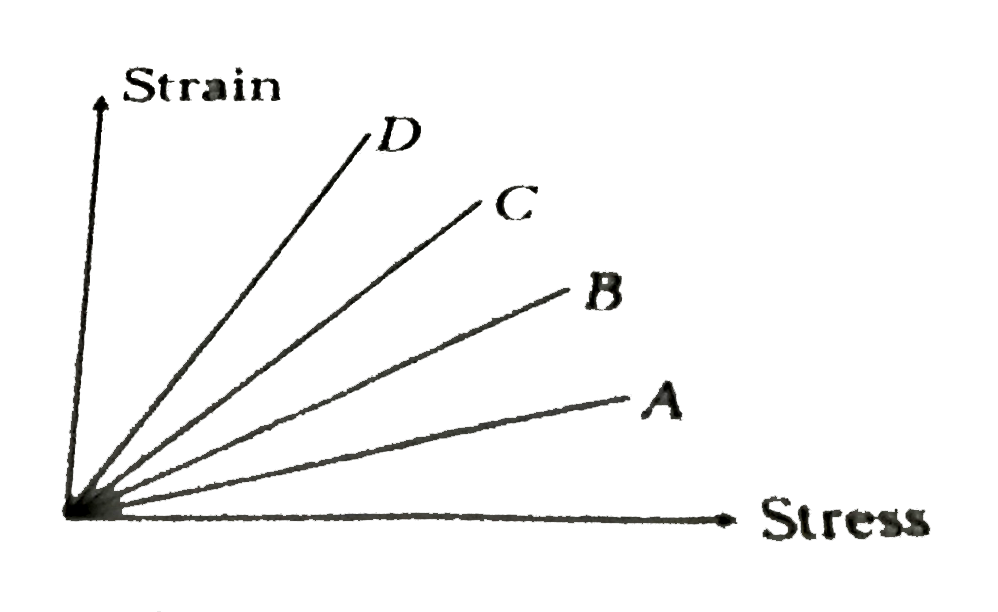Young modulus of elasticity for a gas is
Unity
Infinite
Zero
None of these
To find the Young's modulus of elasticity for a gas, we need to understand the relationship between stress and strain in the context of gases. Young's modulus (E) is defined as the ratio of tensile stress to tensile strain in a material. However, for gases, the concept of Young's modulus is not directly applicable in the same way as it is for solids.
1. Understanding Young's Modulus:
Young's modulus (E) is defined as:
E=StressStrain
where stress is defined as force per unit area and strain is the relative change in length.
2. Stress in Gases:
For a gas, the stress can be defined as:
Stress=FA
where F is the force applied and A is the area over which the force is applied.
3. Strain in Gases:
Strain in the context of gases can be defined as the change in volume per unit volume, which is not the same as linear strain used for solids. For gases, we often refer to volumetric strain:
Strain=ΔVV
where ΔV is the change in volume and V is the original volume.
4. Young's Modulus for Gases:
Since gases can expand and compress significantly, the relationship between stress and strain is not linear as in solids. Therefore, Young's modulus for gases is often considered to be very low or undefined in the classical sense. Instead, we use the bulk modulus (K) for gases, which is defined as:
K=−PΔV/V
where P is the pressure applied to the gas.
5. Conclusion:
Therefore, the Young's modulus of elasticity for a gas is not defined in the same way as for solids. Instead, we refer to the bulk modulus, which describes the compressibility of gases.
Final Answer:
The Young's modulus of elasticity for a gas is essentially undefined or very low, and we typically use the bulk modulus instead.
Young's modulus (E) is defined as:
E=StressStrain
where stress is defined as force per unit area and strain is the relative change in length.
For a gas, the stress can be defined as:
Stress=FA
where F is the force applied and A is the area over which the force is applied.
Strain in the context of gases can be defined as the change in volume per unit volume, which is not the same as linear strain used for solids. For gases, we often refer to volumetric strain:
Strain=ΔVV
where ΔV is the change in volume and V is the original volume.
Since gases can expand and compress significantly, the relationship between stress and strain is not linear as in solids. Therefore, Young's modulus for gases is often considered to be very low or undefined in the classical sense. Instead, we use the bulk modulus (K) for gases, which is defined as:
K=−PΔV/V
where P is the pressure applied to the gas.
Therefore, the Young's modulus of elasticity for a gas is not defined in the same way as for solids. Instead, we refer to the bulk modulus, which describes the compressibility of gases.
The Young's modulus of elasticity for a gas is essentially undefined or very low, and we typically use the bulk modulus instead.
Topper's Solved these Questions
- MECHANICAL PROPERTIES OF SOLIDSBook:AAKASH INSTITUTEChapter:MECHANICAL PROPERTIES OF SOLIDSExercise:Assignment(Section-A)
Explore 52 Videos
- MECHANICAL PROPERTIES OF SOLIDSBook:AAKASH INSTITUTEChapter:MECHANICAL PROPERTIES OF SOLIDSExercise:Assignment(Section-B)
Explore 24 Videos
- MECHANICAL PROPERTIES OF SOLIDSBook:AAKASH INSTITUTEChapter:MECHANICAL PROPERTIES OF SOLIDSExercise:Assignment (SECTION - J)
Explore 1 Video
- MECHANICAL PROPERTIES OF FLUIDSBook:AAKASH INSTITUTEChapter:MECHANICAL PROPERTIES OF FLUIDSExercise:SECTION - J
Explore 9 Videos
- Mock test 03Book:AAKASH INSTITUTEChapter:Mock test 03Exercise:EXAMPLE
Explore 37 Videos
Similar Questions
Knowledge Check
Adiabatic modulus of elasticity of a gas is 2.1×105N/m2. What will be isothermal modulus if elasticity (CpCv=1.4)
A1.8×105N/m2B1.5×105N/m2C1.4×105N/m2D1.2×105N/m2Assertion Bulk modulus of elasticity of gases is pressure dependent.
Reason More the pressure of gas, more is the Bulk modulus of elasticity of gas.AIf both Assertion and Reason are true and Reason is the correct explanation of Assertion.BIf both Assertion and Reason are true but Reason is not the correct explanation of Assertion.CIf Assertion is true but Reason is false.DIf both Assertion and Reason are false.The ratio of adiabatic and isothermal bulk modulus of elasticity for a perfect gas is
AγBγ2C1/γD1/γ2
Young's modulus.
View SolutionStress-strain curve for four metals are shown in figure. The maximum Young's modulus of elasticity is for metal

View SolutionYoung's modulus of elasticity is the ratio of
View SolutionThe units of Young's modulus of elasticity are
View SolutionThe maximum error in calculation of Young's modulus of elasticity of the wire is
View Solution
